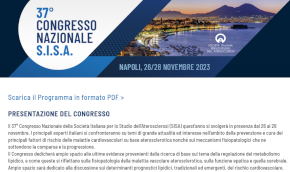 Rivista in lingua italiana
Rivista in lingua italiana
riservata ai Soci SISA
Ultimo numero:
Anno 14 • N.4/2023
Abstract
Major lipids, apolipoproteins, and risk of vascular disease
Emerging Risk Factors Collaboration, Di Angelantonio E, Sarwar N, Perry P, Kaptoge S, Ray KK, Thompson A, Wood AM, Lewington S, Sattar N, Packard CJ, Collins R, Thompson SG, Danesh J.
JAMA 2009;302:1993-2000
CONTEXT: Associations of major lipids and apolipoproteins with the risk of vascular disease have not been reliably quantified. OBJECTIVE: To assess major lipids and apolipoproteins in vascular risk. DESIGN, SETTING, AND PARTICIPANTS: Individual records were supplied on 302,430 people without initial vascular disease from 68 long-term prospective studies, mostly in Europe and North America. During 2.79 million person-years of follow-up, there were 8857 nonfatal myocardial infarctions, 3928 coronary heart disease [CHD] deaths, 2534 ischemic strokes, 513 hemorrhagic strokes, and 2536 unclassified strokes. MAIN OUTCOME MEASURES: Hazard ratios (HRs), adjusted for several conventional factors, were calculated for 1-SD higher values: 0.52 log(e) triglyceride, 15 mg/dL high-density lipoprotein cholesterol (HDL-C), 43 mg/dL non-HDL-C, 29 mg/dL apolipoprotein AI, 29 mg/dL apolipoprotein B, and 33 mg/dL directly measured low-density lipoprotein cholesterol (LDL-C). Within-study regression analyses were adjusted for within-person variation and combined using meta-analysis. RESULTS: The rates of CHD per 1000 person-years in the bottom and top thirds of baseline lipid distributions, respectively, were 2.6 and 6.2 with triglyceride, 6.4 and 2.4 with HDL-C, and 2.3 and 6.7 with non-HDL-C. Adjusted HRs for CHD were 0.99 (95% CI, 0.94-1.05) with triglyceride, 0.78 (95% CI, 0.74-0.82) with HDL-C, and 1.50 (95% CI, 1.39-1.61) with non-HDL-C. Hazard ratios were at least as strong in participants who did not fast as in those who did. The HR for CHD was 0.35 (95% CI, 0.30-0.42) with a combination of 80 mg/dL lower non-HDL-C and 15 mg/dL higher HDL-C. For the subset with apolipoproteins or directly measured LDL-C, HRs were 1.50 (95% CI, 1.38-1.62) with the ratio non-HDL-C/HDL-C, 1.49 (95% CI, 1.39-1.60) with the ratio apo B/apo AI, 1.42 (95% CI, 1.06-1.91) with non-HDL-C, and 1.38 (95% CI, 1.09-1.73) with directly measured LDL-C. Hazard ratios for ischemic stroke were 1.02 (95% CI, 0.94-1.11) with triglyceride, 0.93 (95% CI, 0.84-1.02) with HDL-C, and 1.12 (95% CI, 1.04-1.20) with non-HDL-C. CONCLUSION: Lipid assessment in vascular disease can be simplified by measurement of either total and HDL cholesterol levels or apolipoproteins without the need to fast and without regard to triglyceride.

Area Soci
Eventi



 SISA LIPID ACADEMY - Corso avanzato di lipidologia clinica
SISA LIPID ACADEMY - Corso avanzato di lipidologia clinicaModena, 22-23 Giugno 2023
[continua a leggere]Giornale Italiano Arteriosclerosi
HoFH today
 Rivista Italiana della
Rivista Italiana della
Ipercolesterolemia
Familiare Omozigote
Anno 5 • N.1/2023
Rivista NMCD
Diateca
[continua a leggere]
[continua a leggere]
Newsletter
il vostro indirizzo di posta elettronica
Progetto LIPIGEN

Nuovo sito dedicato al Progetto LIPIGEN
Progetto LIPIGEN - Vecchio portale
E' necessario essere loggati come utente
Lipigen per poter accedere alla pagina
PROject Statin Intolerance SISA
PROSISA – PROject Statin Intolerance SISA
E' necessario essere loggati come utente
PROSISA per poter accedere alla pagina
GILA - Lipoprotein Aferesi
Gruppo Interdisciplinare Lipoprotein Aferesi
(Accesso Gruppo GILA-Lipoprotein Aferesi)
E' necessario essere loggati come utente del Gruppo GILA per poter accedere
Gruppo Interdisciplinare Lipoprotein Aferesi
(Documentazione ad accesso libero)
Pagina informativa per medici e pazienti








